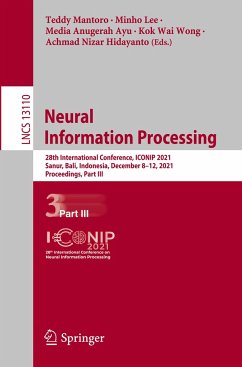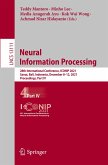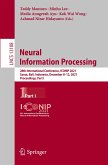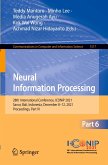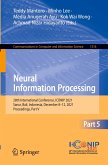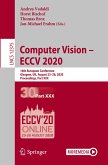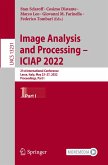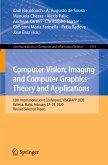Neural Information Processing
28th International Conference, ICONIP 2021, Sanur, Bali, Indonesia, December 8-12, 2021, Proceedings, Part III
Herausgegeben:Mantoro, Teddy; Lee, Minho; Ayu, Media Anugerah; Wong, Kok Wai; Hidayanto, Achmad Nizar
Neural Information Processing
28th International Conference, ICONIP 2021, Sanur, Bali, Indonesia, December 8-12, 2021, Proceedings, Part III
Herausgegeben:Mantoro, Teddy; Lee, Minho; Ayu, Media Anugerah; Wong, Kok Wai; Hidayanto, Achmad Nizar
- Broschiertes Buch
- Merkliste
- Auf die Merkliste
- Bewerten Bewerten
- Teilen
- Produkt teilen
- Produkterinnerung
- Produkterinnerung
The four-volume proceedings LNCS 13108, 13109, 13110, and 13111 constitutes the proceedings of the 28th International Conference on Neural Information Processing, ICONIP 2021, which was held during December 8-12, 2021. The conference was planned to take place in Bali, Indonesia but changed to an online format due to the COVID-19 pandemic.
The total of 226 full papers presented in these proceedings was carefully reviewed and selected from 1093 submissions. The papers were organized in topical sections as follows:
Part I: Theory and algorithms;
Part II: Theory and algorithms; human…mehr
Andere Kunden interessierten sich auch für
![Neural Information Processing Neural Information Processing]() Neural Information Processing77,99 €
Neural Information Processing77,99 €![Neural Information Processing Neural Information Processing]() Neural Information Processing77,99 €
Neural Information Processing77,99 €![Neural Information Processing Neural Information Processing]() Neural Information Processing93,99 €
Neural Information Processing93,99 €![Neural Information Processing Neural Information Processing]() Neural Information Processing93,99 €
Neural Information Processing93,99 €![Computer Vision - ECCV 2020 Computer Vision - ECCV 2020]() Computer Vision - ECCV 202039,99 €
Computer Vision - ECCV 202039,99 €![Image Analysis and Processing ¿ ICIAP 2022 Image Analysis and Processing ¿ ICIAP 2022]() Image Analysis and Processing ¿ ICIAP 202285,99 €
Image Analysis and Processing ¿ ICIAP 202285,99 €![Computer Vision, Imaging and Computer Graphics Theory and Applications Computer Vision, Imaging and Computer Graphics Theory and Applications]() Computer Vision, Imaging and Computer Graphics Theory and Applications77,99 €
Computer Vision, Imaging and Computer Graphics Theory and Applications77,99 €-
-
-
The four-volume proceedings LNCS 13108, 13109, 13110, and 13111 constitutes the proceedings of the 28th International Conference on Neural Information Processing, ICONIP 2021, which was held during December 8-12, 2021. The conference was planned to take place in Bali, Indonesia but changed to an online format due to the COVID-19 pandemic.
The total of 226 full papers presented in these proceedings was carefully reviewed and selected from 1093 submissions. The papers were organized in topical sections as follows:
Part I: Theory and algorithms;
Part II: Theory and algorithms; human centred computing; AI and cybersecurity;
Part III: Cognitive neurosciences; reliable, robust, and secure machine learning algorithms; theory and applications of natural computing paradigms; advances in deep and shallow machine learning algorithms for biomedical data and imaging; applications;
Part IV: Applications.
The total of 226 full papers presented in these proceedings was carefully reviewed and selected from 1093 submissions. The papers were organized in topical sections as follows:
Part I: Theory and algorithms;
Part II: Theory and algorithms; human centred computing; AI and cybersecurity;
Part III: Cognitive neurosciences; reliable, robust, and secure machine learning algorithms; theory and applications of natural computing paradigms; advances in deep and shallow machine learning algorithms for biomedical data and imaging; applications;
Part IV: Applications.
Produktdetails
- Produktdetails
- Theoretical Computer Science and General Issues 13110
- Verlag: Springer / Springer International Publishing / Springer, Berlin
- Artikelnr. des Verlages: 978-3-030-92237-5
- 1st ed. 2021
- Seitenzahl: 732
- Erscheinungstermin: 5. Dezember 2021
- Englisch
- Abmessung: 235mm x 155mm x 40mm
- Gewicht: 1089g
- ISBN-13: 9783030922375
- ISBN-10: 3030922375
- Artikelnr.: 62835248
- Herstellerkennzeichnung Die Herstellerinformationen sind derzeit nicht verfügbar.
- Theoretical Computer Science and General Issues 13110
- Verlag: Springer / Springer International Publishing / Springer, Berlin
- Artikelnr. des Verlages: 978-3-030-92237-5
- 1st ed. 2021
- Seitenzahl: 732
- Erscheinungstermin: 5. Dezember 2021
- Englisch
- Abmessung: 235mm x 155mm x 40mm
- Gewicht: 1089g
- ISBN-13: 9783030922375
- ISBN-10: 3030922375
- Artikelnr.: 62835248
- Herstellerkennzeichnung Die Herstellerinformationen sind derzeit nicht verfügbar.
Cognitive Neurosciences.- A Novel Binary BCI Systems Based on Non-oddball Auditory and Visual Paradigms.- A Just-In-Time Compilation Approach for Neural Dynamics Simulation.- STCN-GR: Spatial-Temporal Convolutional Networks for Surface-Electromyography-Based Gesture Recognition.- Gradient descent learning algorithm based on spike selection mechanism for multilayer spiking neural networks.- Learning to Coordinate via Multiple Graph Neural Networks.- A Reinforcement Learning Approach for Abductive Natural Language Generation.- DFFCN: Dual Flow Fusion Convolutional Network for Micro Expression Recognition.- AUPro: Multi-label Facial Action Unit Proposal Generation for Sequence-level Analysis.- Deep kernelized network for fine-grained recognition.- Semantic Perception Swarm Policy with Deep Reinforcement Learning.- Reliable, Robust, and Secure Machine Learning Algorithms Open-Set Recognition with Dual Probability Learning.- How Much Do Synthetic Datasets Matter In Handwritten Text Recognition.- PCMO: Partial Classification from CNN-Based Model Outputs.- Multi-branch Fusion Fully Convolutional Network for Person Re-Identification.- Fast Organization of Objects Spatial Positions in Manipulator Space from Single RGB-D Camera.- EvoBA: An Evolution Strategy as a Strong Baseline for Black-Box Adversarial Attacks.- A Novel Oversampling Technique for Imbalanced Learning Based on SMOTE and Genetic Algorithm.- Dy-Drl2Op: Learning Heuristics for TSP on the Dynamic Graph via Deep Reinforcement Learning.- Multi-label classification of hyperspectral images based on label-specific feature fusion.- A Novel Multi-Scale Key-Point Detector Using Residual Dense Block and Coordinate Attention.- Alleviating Catastrophic Interference in Online Learning via Varying Scale of Backward Queried Data.- Construction and Reasoning for Interval-Valued EBRB Systems.- Theory and Applications of Natural Computing Paradigms.- Brain-mimetic Kernel: A Kernel Constructed from Human fMRI Signals Enabling aBrain-mimetic Visual Recognition Algorithm.- Predominant Sense Acquisition with a Neural Random Walk Model.- Processing-response dependence on the on-chip readout positions in spin-wave reservoir computing.- Advances in deep and shallow machine learning algorithms for biomedical data and imaging.- A Multi-Task Learning Scheme for Motor Imagery Signal Classification.- An End-to-End Hemisphere Discrepancy Network for Subject-Independent Motor Imagery Classification.- Multi-domain Abdomen Image Alignment Based on Joint Network of Registration and Synthesis.- Coordinate Attention Residual Deformable U-Net for Vessel Segmentation.- Gated Channel Attention Network for Cataract Classification on AS-OCT Image.- Overcoming Data Scarcity for Coronary Vessel Segmentation Through Self-Supervised Pre-Training.- Self-Attention Long-Term Dependency Modelling in Electroencephalography Sleep Stage Prediction.- ReCal-Net: Joint Region-Channel-Wise Calibrated Network for Semantic Segmentation in Cataract Surgery Videos.- Enhancing Dermoscopic Features Classification in Images Using Invariant Dataset Augmentation and Convolutional Neural Networks.- Ensembles of Randomized Neural Networks for Pattern-based Time Series Forecasting.- Grouped Echo State Network with Late Fusion for Speech Emotion Recognition.- Applications.- MPANet: Multi-level Progressive Aggregation Network for Crowd Counting.- AFLLC: A Novel Active Contour Model based on Adaptive Fractional Order Differentiation and Local Linearly Constrained Bias Field.- DA-GCN: A Dependency-Aware Graph Convolutional Network for Emotion Recognition in Conversations.- Semi-Supervised Learning with Conditional GANs for Blind Generated Image Quality Assessment.- Uncertainty-Aware Domain Adaptation for Action Recognition.- Free-Form Image Inpainting with Separable Gate Encoder-decoder Network.- BERTDAN: Question-Answer Dual Attention Fusion Networks With Pre-trained Models for Answer Selection.- Rethinking the Effectiveness of Selective Attention in Neural Networks.- An Attention Method to Introduce Prior Knowledge in Dialogue State Tracking.- Effect of Input Noise Dimension in GANs.- Wiper Arm Recognition using YOLOv4.- Context Aware Joint Modeling of Domain Classification, Intent Detection and Slot Filling with Zero-shot Intent Detection Approach.- Constrained Generative Model for EEG Signals Generation.- Top-Rank Learning Robust to Outliers.- Novel GAN Inversion Model with Latent Space Constraints for Face Reconstruction.- Edge Guided Attention Based Densely Connected Network for Single Image Super-Resolution.- An Agent-Based Market Simulator for Back-testing Deep Reinforcement Learning Based Trade Execution Strategies.- Looking beyond the haze: A Pyramid Fusion Approach.- DGCN-rs: a Dilated Graph Convolutional Networks Jointly Modelling Relation and Semantic for Multi-Event Forecasting.- Training Graph Convolutional Neural Network against Label Noise.- An LSTM-based Plagiarism Detection via Attention Mechanism anda Population-based Approach for Pre-Training Parameters with imbalanced Classes.
Cognitive Neurosciences.- A Novel Binary BCI Systems Based on Non-oddball Auditory and Visual Paradigms.- A Just-In-Time Compilation Approach for Neural Dynamics Simulation.- STCN-GR: Spatial-Temporal Convolutional Networks for Surface-Electromyography-Based Gesture Recognition.- Gradient descent learning algorithm based on spike selection mechanism for multilayer spiking neural networks.- Learning to Coordinate via Multiple Graph Neural Networks.- A Reinforcement Learning Approach for Abductive Natural Language Generation.- DFFCN: Dual Flow Fusion Convolutional Network for Micro Expression Recognition.- AUPro: Multi-label Facial Action Unit Proposal Generation for Sequence-level Analysis.- Deep kernelized network for fine-grained recognition.- Semantic Perception Swarm Policy with Deep Reinforcement Learning.- Reliable, Robust, and Secure Machine Learning Algorithms Open-Set Recognition with Dual Probability Learning.- How Much Do Synthetic Datasets Matter In Handwritten Text Recognition.- PCMO: Partial Classification from CNN-Based Model Outputs.- Multi-branch Fusion Fully Convolutional Network for Person Re-Identification.- Fast Organization of Objects Spatial Positions in Manipulator Space from Single RGB-D Camera.- EvoBA: An Evolution Strategy as a Strong Baseline for Black-Box Adversarial Attacks.- A Novel Oversampling Technique for Imbalanced Learning Based on SMOTE and Genetic Algorithm.- Dy-Drl2Op: Learning Heuristics for TSP on the Dynamic Graph via Deep Reinforcement Learning.- Multi-label classification of hyperspectral images based on label-specific feature fusion.- A Novel Multi-Scale Key-Point Detector Using Residual Dense Block and Coordinate Attention.- Alleviating Catastrophic Interference in Online Learning via Varying Scale of Backward Queried Data.- Construction and Reasoning for Interval-Valued EBRB Systems.- Theory and Applications of Natural Computing Paradigms.- Brain-mimetic Kernel: A Kernel Constructed from Human fMRI Signals Enabling aBrain-mimetic Visual Recognition Algorithm.- Predominant Sense Acquisition with a Neural Random Walk Model.- Processing-response dependence on the on-chip readout positions in spin-wave reservoir computing.- Advances in deep and shallow machine learning algorithms for biomedical data and imaging.- A Multi-Task Learning Scheme for Motor Imagery Signal Classification.- An End-to-End Hemisphere Discrepancy Network for Subject-Independent Motor Imagery Classification.- Multi-domain Abdomen Image Alignment Based on Joint Network of Registration and Synthesis.- Coordinate Attention Residual Deformable U-Net for Vessel Segmentation.- Gated Channel Attention Network for Cataract Classification on AS-OCT Image.- Overcoming Data Scarcity for Coronary Vessel Segmentation Through Self-Supervised Pre-Training.- Self-Attention Long-Term Dependency Modelling in Electroencephalography Sleep Stage Prediction.- ReCal-Net: Joint Region-Channel-Wise Calibrated Network for Semantic Segmentation in Cataract Surgery Videos.- Enhancing Dermoscopic Features Classification in Images Using Invariant Dataset Augmentation and Convolutional Neural Networks.- Ensembles of Randomized Neural Networks for Pattern-based Time Series Forecasting.- Grouped Echo State Network with Late Fusion for Speech Emotion Recognition.- Applications.- MPANet: Multi-level Progressive Aggregation Network for Crowd Counting.- AFLLC: A Novel Active Contour Model based on Adaptive Fractional Order Differentiation and Local Linearly Constrained Bias Field.- DA-GCN: A Dependency-Aware Graph Convolutional Network for Emotion Recognition in Conversations.- Semi-Supervised Learning with Conditional GANs for Blind Generated Image Quality Assessment.- Uncertainty-Aware Domain Adaptation for Action Recognition.- Free-Form Image Inpainting with Separable Gate Encoder-decoder Network.- BERTDAN: Question-Answer Dual Attention Fusion Networks With Pre-trained Models for Answer Selection.- Rethinking the Effectiveness of Selective Attention in Neural Networks.- An Attention Method to Introduce Prior Knowledge in Dialogue State Tracking.- Effect of Input Noise Dimension in GANs.- Wiper Arm Recognition using YOLOv4.- Context Aware Joint Modeling of Domain Classification, Intent Detection and Slot Filling with Zero-shot Intent Detection Approach.- Constrained Generative Model for EEG Signals Generation.- Top-Rank Learning Robust to Outliers.- Novel GAN Inversion Model with Latent Space Constraints for Face Reconstruction.- Edge Guided Attention Based Densely Connected Network for Single Image Super-Resolution.- An Agent-Based Market Simulator for Back-testing Deep Reinforcement Learning Based Trade Execution Strategies.- Looking beyond the haze: A Pyramid Fusion Approach.- DGCN-rs: a Dilated Graph Convolutional Networks Jointly Modelling Relation and Semantic for Multi-Event Forecasting.- Training Graph Convolutional Neural Network against Label Noise.- An LSTM-based Plagiarism Detection via Attention Mechanism anda Population-based Approach for Pre-Training Parameters with imbalanced Classes.

